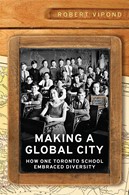Clinton Street Public School Through the Years
Clinton was established in 1888, the direct result of the extraordinary growth of Toronto that pushed residential settlement beyond what we now think of as the downtown core. (Between 1881 and 1891 – just one decade – the population of Toronto more than doubled in size from about 86,000 to 181,000.)The original Clinton was a two-story, eight-room brick building that faced onto Clinton Street. In fact, it was too small from the outset, and soon enough a third floor was added. But even this addition could not meet demand, so, in 1913, a stately, three-story Edwardian building was constructed facing Manning Avenue. In 1923, an annex was built that connected the original school to the new one. And so it remained until 1966, when the “old” schools were demolished and the current building constructed. In an article written for the Toronto Star’s special centennial edition of July 1, 1967, a reporter gushed over Clinton’s state-of-the-art facilities: “The children there have the most modern teaching aids while at classes and all the fun of the fair at recess… The auditorium-cum-gymnasium has a full-size stage, fancy lighting and dressing rooms.” And the library in a modern school like Clinton, the article continued, “is now called a ‘resource centre’ because it’s loaded with electronic information gadgets as well as books”.
When the original Clinton Street School first opened its doors, the community from which it drew, and hence its student body, was largely British by origin, middle class by status, and Protestant or Anglican by belief. And so it remained until the First World War – largely unaffected, as one journalist put it, “by the influx of foreign-born population.” And then, in the blink of a demographer’s eye, the neighbourhood changed dramatically. The area around Clinton became a magnet for new immigrants to Canada, and Clinton itself became a gateway school for their children. The story of Clinton through the 20th Century is the story of three distinct waves of immigrants – Jewish immigration to Clinton (1920s to the early 1950s); southern European immigration to Clinton (early 1950s to the mid-1970s); and global immigration to Clinton (from the mid-1970s to the 1990s).What makes the history of Clinton so interesting and important is that the school became a living laboratory for working out how to integrate immigrant children into Canadian life. In many ways, the story of Clinton is the story of Toronto – or even Canada – in miniature. (I explore this theme in my recent book about Clinton – Making a Global City: How One Toronto School Embraced Diversity [University of Toronto Press, 2017]).
Schools like Clinton became crucibles of integration in part because they provided knowledge and skills that students needed, in the words of Morley Safer (Clinton class of 1946), to be “kicked up the social ladder.” In Safer’s day, instruction was much more formal than it is now. Teachers talked and students listened, seated in rows of desks bolted to the floor. Principals were men, most teachers were women, girls took classes in “household science” , and boys enrolled in “manual training.” Clinton introduced kindergarten classes in 1897 – one of the first in Toronto and well ahead of the curve in North America. Until 1958, students attended Clinton through Grade 8. And from 1924 to 1953, Clinton was the hub for deaf education in Toronto.
But school life was never just about drills, memorization, and the three R's. Sports have always been important at Clinton, as has music, and drama. Special projects and excursions have always had an important place as well, and since the early 1960s the opportunity to experience urban camping at the Island School has been a fixture of student life.
In the midst of the First World War, the journalist W.A. Craik wrote a series of feature articles for the Star Weekly in which he reported on visits to sixty-four different public schools in Toronto. Clinton, which Craik toured in the fall of 1917, did well. It enjoyed, he said, a reputation “both for a fine school spirit and good scholarship. ”A century on, this reputation remains intact. Long may it continue.
Rob Vipond
Professor and former Clinton parent
Please click below for a link to University of Toronto Press' page for Professor Vipond's book examining Clinton Street PS' heritage and how the changes in our school's community reflected the growth both of the city of Toronto, and the country of Canada. The book is entitled 'Making a Global City: How One Toronto School Embraced Diversity.'
https://utorontopress.com/9781442631953/making-a-global-city/


